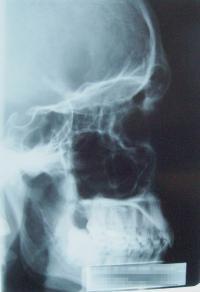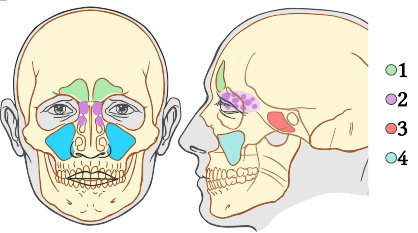鼻窦
四对鼻窦
每个人都有四对鼻窦,根据所在的头骨部位而命名。这四对鼻窦的名称分别是:
上颌窦(Maxillary Sinuses):位于眼睛之下的上颔骨,是四对鼻窦中体积最大的一对。
额窦(frontal Sinuses):位于眼睛之上的额骨。
筛窦(ethmoid Sinuses):位于眼睛和鼻之间的筛骨,并向后通往头颅。
蝶窦(sphenoid Sinuses):位于头颅骨底部的中心。
这四对鼻窦于头的左右侧各一,共八个。
结构
Humans possess four paired paranasal sinuses, divided into subgroups that are named according to thebones within which the sinuses lie:
The maxillary sinus ( 英语 : maxillary sinus ) es, the largest of the paranasal sinuses, are under theeyes, in the maxillary bones (open in the back of the semilunar hiatus ( 英语 : semilunar hiatus ) of the nose). They are innervated by thetrigeminal nerve.
Thefrontal sinuses, superior to the eyes, in thefrontal bone, which forms the hard part of theforehead. They are also innervated by thetrigeminal nerve.
The ethmoidal sinus ( 英语 : ethmoid sinus ) es, which are formed from several discrete air cells within theethmoid bonebetween the nose ( 英语 : human nose ) and the eyes. They are innervated by the ethmoidal nerves ( 英语 : ethmoidal nerves ) , which branch from the nasociliary nerve ( 英语 : nasociliary nerve ) of thetrigeminal nerve.
The sphenoidal sinus ( 英语 : sphenoid sinus ) es, in thesphenoid bone. They are innervated by the trigeminal nerve.
The paranasal air sinuses are lined with respiratory epithelium ( 英语 : respiratory epithelium ) (ciliated pseudostratified columnar epithelium).
作用
医学界对鼻窦在人体内的作用还未很清楚。不过,下列各项原因都有可能:
减轻头颅骨前方的重量
帮助令吸入的空气在到达肺部之前,可以更温暖和湿润
帮助增强发声时的共鸣
当脸部受到袭击时,可以当作一个力量的缓冲区
功能

Lateral projection of the paranasal sinuses as seen in an X-ray image
The biological role of the sinuses is debated, but a number of possible functions have been proposed:
Decreasing the relative weight of the front of the skull, and especially the bones of the face.
Increasing resonance of thevoice.
Providing a buffer against facial trauma.
Insulating sensitive structures like dental roots and eyes from rapid temperature fluctuations in the nasal cavity.
Humidifying and heating of inhaled air because of slow air turnover in this region.
Regulation of intranasal and serum gas pressures.
Immunological defense.
鼻窦炎
鼻窦由很多称为 窦口 ( 英语 : Sinus ostia ) 的小管连往鼻腔。不过当人因为普通感冒而引致鼻炎或鼻膜肿胀,都会使这些小管闭塞。当这些小管闭塞时,就会影响到鼻腔黏液滞流在鼻窦内,影响排放。如果不及早诊治,就会演变成为鼻窦炎。
Inflammation
The paranasal sinuses are joined to thenasal cavityvia small orifices called ostia ( 英语 : sinus ostia ) . These become blocked easily by allergic inflammation, or by swelling in the nasal lining that occurs with acold. If this happens, normal drainage ofmucuswithin the sinuses is disrupted, andsinusitismay occur. Because the maxillary posterior teeth are close to the maxillary sinus, this can also cause clinical problems if any disease processes are present, such as an infection in any of these teeth. These clinical problems can include secondary sinusitis, the inflammation of the sinuses from another source such as an infection of the adjacent teeth.
These conditions may be treated with drugs such as decongestant ( 英语 : decongestant ) s, which cause vasoconstriction in the sinuses; reducing inflammation; by traditional techniques ofnasal irrigation; or bycorticosteroid.
Development
Paranasal sinuses form developmentally through excavation of bone by air-filled sacs ( pneumatic diverticula ( 英语 : skeletal pneumaticity ) ) from thenasal cavity. This process begins prenatally, and it continues through the course of an organism"s lifetime.
The results of experimental studies suggest that the natural ventilation-rate of a sinus with a single sinus ostium ( 英语 : sinus ostium ) (opening), is extremely slow. Such limited ventilation may be protective for the sinus, as it would help prevent drying of its mucosal surface and maintain a near-sterile environment with highcarbon dioxideconcentrations and minimalpathogenaccess. Thus composition of gas content in the maxillary sinus is similar tovenous blood, with high carbon dioxide and loweroxygenlevels compared to breathing air.
Clinical relevance
Cancer
Malignancies of the paranasal sinuses comprise approximately 0.2% of all malignancies. About 80% of these malignancies arise in the maxillary sinus. Men are much more often affected than women. They most often occur in the age group between 40 and 70 years.Carcinomas are more frequent thansarcomas. Metastases are rare.Tumours of the sphenoid and frontal sinuses are extremely rare.
历史
词源
Sinus is aLatinword meaning a "fold", "curve", or "bay".
其他动物
Paranasal sinuses occur in many other animals, including most哺乳动物、鸟、non-avian恐龙和鳄目。The bones occupied by sinuses are quite variable in these other species.
图片

Paranasal sinuses
参见
本条目使用了部分解剖术语,概述请参阅 这里 ( 英语 : anatomical terminology ) 。
免责声明:以上内容版权归原作者所有,如有侵犯您的原创版权请告知,我们将尽快删除相关内容。感谢每一位辛勤著写的作者,感谢每一位的分享。

- 有价值
- 一般般
- 没价值








24小时热门
推荐阅读
关于我们

APP下载



























{{item.time}} {{item.replyListShow ? '收起' : '展开'}}评论 {{curReplyId == item.id ? '取消回复' : '回复'}}